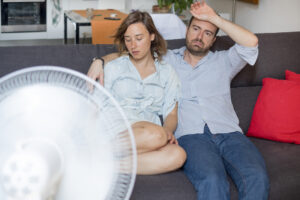Does Setting Back Your AC Save Electricity?
Can You Save Money Setting Back Your AC?

In the relatively short Texas winters, residents cut down heating costs by setting their thermostats a little cooler and wearing warmer clothing. However, Texas summers call for people to set back their thermostats a little warmer, run ceiling fans at full speed, and shed layers of clothes. But does setting back your AC save electricity? Yes, you can save 10% per year when you set your thermostat back 7° to 10° for eight hours per day, according to the US Department of Energy. But you need to understand how your home’s cooling works to maximize your savings.
Heat Is Drawn To Cold
In winter, you want to keep the heat in. But in summer, you want to keep the heat out. Heat is drawn to cold like mosquitos to a toddler’s chubby arms and legs.
Newton’s Law of Cooling states that heat will transfer to cold more quickly when temperatures are further apart. Therefore, your 74°F home attracts outdoor heat faster at 100°F weather during August than in 80°F during March. Radiant heat from the sun and air leaks cause your air conditioner to run longer, raising your Texas electricity bill.
Installing a radiant barrier in your attic is a good long-term investment. It lowers the temperature of your attic by trapping a layer of air between the roof decking and the barrier. That warm air can escape through your attic’s ridge vent. Additionally, your ductwork running through your attic stays cooler which makes your HVAC system run more efficiently. The efficiency gains are even more significant when the home’s furnace is in the attic.
Sealing air leaks also helps your HVAC system’s efficiency. Warm air seeps in through gaps, and your AC system has to then cool that air. The more gaps you seal, the fewer intrusions from warm air impact your AC’s operation. Companies specializing in making homes energy efficient can even prioritize which leaks to fix first based on pressure tests.
That Dreaded Humidity
Texas humidity doesn’t impact your home’s temperature. However, higher levels of humidity make you feel warmer. Have you ever seen a “feels like” or “heat index” temperature in a television weather forecast? Humidity is the main factor in why that number is higher than the actual temperature. At higher humidities, you’ll be tempted to set your thermostat lower than in less humid times.
Dehumidifiers can be a good investment for Texas summers. These appliances dry out the air to make it feel cooler. And you’ll be less tempted to crank down the AC.
Setting Back Your AC
Strategically set back your AC to warmer settings in the summer. When mornings are cooler, you don’t have to set back the AC as far. Imagine you've experienced a relatively cool overnight temperature of 72 °F for several hours. If you keep your thermostat at 74°F , your AC shouldn't kick on until an hour or so after sunrise when radiant heat beams down on your home. As the day warms up, set your thermostat higher to prevent it from running or to keep it running less. The fewer times you hear the condenser fan turn on, the more money you’ll save.
If you commute to work, you definitely want a smart thermostat. These devices learn your comings and goings to set your indoor temperature accordingly. If you don’t have a smart thermostat, set your thermostat to a cooler temperature when you get up. Before you leave, increase the temperature to what you want while you’re away at work. The cooler starting temperature will delay your AC from coming on. But don’t set your "away" temperature too high because you could squander your savings to cool your home when you return. Start at 78°F and see how long it takes to recool your home. If it takes more than an hour, don’t set it so high next time. Remember, you can save up to 10% when you set back your thermostat for eight hours per day.
Shop For Texas Electricity Plans
Texas electricity savings begins well before you touch your thermostat. Shop for the best power plan prices at https://www.texaselectricityratings.com. Having the best plan will maximize your cost savings.
Comments
Post a Comment